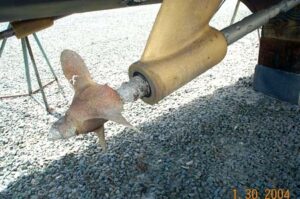FAQs
Zinc FAQs
Any time you have two different metals that are physically or electrically connected and immersed in water, they become a battery.
The electrons that make up that current are supplied by one of the metals giving up bits of itself-in the form of metal ions-to the water. This is called galvanic corrosion and, left unchecked, it quickly destroys underwater metals.

The most common casualty of galvanic corrosion is a bronze or aluminum propeller on a stainless steel shaft, but metal struts, rudders, rudder fittings, outboards, and stern drives basically all metals are at risk.
The way we counteract galvanic corrosion is to add a softer metal into the water for the electrical activity to attack. This piece of metal is called a sacrificial anode, and most often it is zinc. When a zinc is gone, the metal component it was installed to protect begins to dissolve get attacked.
Zincs should be changed when they are about 45-50%. Under normal wear that could be up too 6-8 months but if there is a lot of electrical activity in the water then it could be a lot sooner.
The reason for the 45-50% is the way they are attached is to press them on then bolt it down. If there is no material under the bolts they will fall off.
The zinc should be wearing evenly, not have large pits in them. If there are large pits that means there is a large amount of activity in the water.
NO, not all zincs are the same. Some zinc makers don't make sure they're pouring solid zinc, which means air bubbles can build up in the pour. This means you're getting a liter of zinc that won't wear properly and will break down quickly.
Plus, some zinc producers don't make quality zinc, which isn't soft enough and won't wear at all, so it'll stick to the wrong metals. The cheaper the zinc is made, the shinier it'll be. If it looks dull, that means it's got a low zinc content.
Boat Maintenance FAQs
Recomended cleaning times at every 2 to 3 weeks during warm season and 4 weeks during cold season.
It is no secret that hull cleaning is a bit of a detailed and lengthy process so it requires regular care. Remember that the frequency of cleaning the boat hull is often variable.
If your boat is in warmer water such as in the Southeast region, there are greater chances of fouling. In this instance, it is better to clean your boat’s hull once a week or once every two weeks.
Primary reasons to clean your hull at least monthly.
Blister Accumulation:
Most of the boat hulls are made up of fiberglass. When the water seeps inside the fiberglass, it gives rise to a blister-like appearance on the material which is clear evidence that your boat is going to face significant damage. Keep in mind that repairing fiberglass costs more money than you may expect.
Weakening Of The Boat’s Bottom:
The accumulation of dirt and marine life on the edge of the boat results in the corrosion of the prop, shaft, or any other metal that is used at the bottom of the boat. If you do not pay special attention to the cleanliness of your boat, the diver will tell you shocking news about the corrosion of the bottom region.
Services
Diving
Propeller Servicing (remove, install & repair)
Recovery and Salvage
Dock and Deck Repair
Inspections
Boat Repair
Zinc Changing
Sales and More!

Ready to find out more?
Drop us a line today for a free quote!
